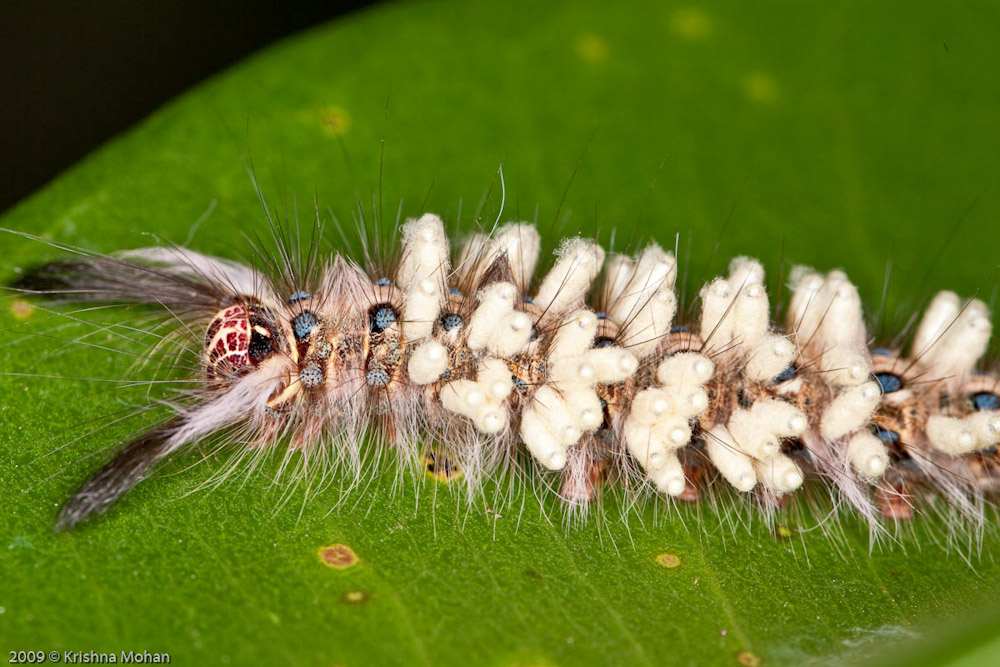
In the last blog I explained about Trabala Species of Lappet Moths. Few days back I found another Trabala caterpillar. This one was infested with pupae of Parasitoid wasps all over its body. It was lethargic and was unable to move.
In general though most people still use the term Parasitic Wasps. Technically speaking, they are not actually parasites – they are parasitoids. This is because a true parasite is something that lives at the expense of its host but doesn’t actually kill it, whereas parasitoids nearly always kill their host.
Parasitoid larvae usually develop by feeding on a single host – different species develop on anything from tiny aphids and insect eggs right up to large butterfly and moth larvae. They can live and feed inside the host’s body cavity (endoparasitoids) or outside the host’s body (ectoparasitoids). They can be solitary or gregarious – with anything from 1 to many 1000’s of larvae consuming the same host.

Fascinating life strategies
Nearly all parasitica inject venom into their host along with or just prior to the egg. This venom is a highly complex mixture of chemicals and other agents used not just to paralyse the host, but to also modify the host’s tissues. Tissue modification is a feature of nearly all venoms, making the host more nutritious for the developing wasp larva and helping to overcome the host’s immune systems. The latter is an especially important consideration for internal parasitoids as a host’s body will usually try to surround (encapsulate) a foreign body to prevent infection and to kill any parasitoid eggs or larvae. Parasitica have developed many ways of getting around this but I think the most devious must be the use of polydnaviruses (also known as Poly-DNA-viruses) . These viruses are injected by some endoparasitoids with the venom and have been shown to target and disable the host’s immune system – thus protecting the developing parasitoid. Other, more basic, methods of bypassing the host’s immune system include laying the egg directly into the host’s brain (ganglion), where the immune system is unable to encapsulate it.
Whichever method the parasitoid uses to prevent encapsulation it must also protect itself against many other dangers. One of the most serious being the possibility that a host will succumb to a fungal or bacterial infection and die before the parasitoid has finished with it. To prevent this, many larvae secrete chemicals with antibiotic or antiseptic properties as they move around the host’s body cavity. They also avoid damaging the host’s gut (a massive source of bacteria) by eating non-essential areas first, like body fat and the reproductive organs. Many species also use teratocytes – bundles of cells that emerge from the egg with the embryo. These cells absorb food from the host’s body cavity and the parasitoid larva feeds on them – removing the need for it to feed directly on the host’s tissues until it is absolutely necessary.

Polyembryony is another complex strategy employed by parasitica, but this time its aim is to ensure the maximum number of offspring from the fewest number of eggs. Some species lay a single egg that continues to divide, cloning itself into many independent larvae – in extreme examples one egg can produce thousands of larvae. Some species have even been shown to produce different types of larvae from the same egg – normal larvae that feed and develop fully into adult wasps and others, which never mature into adult wasps, that act as guards to protect the others from attack by other parasitoid larvae.
Charles Darwin even used one family of Parasitoid wasps as evidence for natural selection, writing to a colleague:
I cannot persuade myself that a beneficent and omnipotent God would have designedly created the Ichneumonidae with the express intention of their feeding within the living bodies of caterpillars.
So what next turn will you see in the story of lappet moths, wait for my last installment on 3 part series on Lappet moths.


Like the details and angle in the second shot.
Beautifully explained.. got to know the difference between parasitics & parasitoids. Thanks for sharing such interesting information.